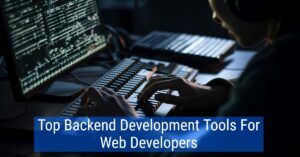Top 7 Tools for Metaverse Development

Metaverse, a term first popularized by science fiction author Neal Stephenson, refers to a virtual world where people can interact with each other and a vast array of digital assets.
Today, the concept of Metaverse is becoming a reality with the rise of virtual reality, augmented reality, and other technologies.
With the increasing interest and investment in Metaverse development, there is a growing need for powerful tools to help developers build and manage these digital worlds.
In this article, we’ll explore the top 7 tools for Metaverse development and what makes them stand out. Whether you’re a seasoned Metaverse developer or just starting out, these tools will help you bring your vision to life.
Top Tools for Metaverse Development
Unity
Unity is a popular game engine and tool for creating immersive experiences, including those in virtual and augmented reality. It has a user-friendly interface and supports various platforms, making it accessible for developers of all skill levels.
Unity also provides features such as physics simulation, animation, and real-time rendering, making it a powerful tool for creating interactive environments in the metaverse.
Additionally, its strong community and asset store provide a wealth of resources for developers to utilize in their projects. Unity’s versatility and ease of use make it a top choice for metaverse development with keeping metaverse trends in 2023 in mind.
Unreal Engine
Unreal Engine is a powerful game engine that provides a comprehensive set of tools for metaverse development. With its robust graphics engine and intuitive user interface, developers can quickly and easily create highly immersive virtual worlds that are optimized for real-time performance.
The engine includes advanced features such as dynamic lighting and shadows, physics simulation, and support for virtual reality and augmented reality technologies, making it ideal for creating complex and interactive metaverse environments.
In addition, Unreal Engine has a large and active community of developers, providing extensive resources and support for those looking to create engaging virtual experiences.
Godot
Godot is a popular game engine and tool for metaverse development. It offers an array of features for game developers, including a flexible scripting language, physics engine, animation tools, and robust support for 2D and 3D graphics.
With its simple and intuitive interface, Godot makes it easy for developers to create immersive and interactive metaverse environments.
Additionally, Godot is open-source and cross-platform, so it can be used on a variety of platforms and devices, including Windows, Mac, Linux, and mobile devices.
Whether you’re looking to build a virtual world or a multiplayer game, Godot provides a powerful and accessible solution for metaverse development.
CryEngine
CryEngine is a powerful game engine specifically designed for metaverse development. It offers a suite of tools that enable developers to create immersive and interactive virtual worlds.
The engine features advanced graphics and lighting systems, real-time physics simulation, and networking capabilities, making it ideal for building multiplayer experiences.
CryEngine also includes an extensive library of assets and resources, such as characters, environments, and animations, which can be easily customized to meet the needs of individual projects.
Additionally, the engine is highly optimized, making it capable of delivering smooth and stable performance even in demanding environments.
Blender
Blender is a popular open-source 3D graphics software used for creating animations, visual effects, and games. It is widely used in the metaverse development community, due to its versatility and powerful features.
Blender has a user-friendly interface, a vast library of add-ons, and a supportive community. With its ability to model, sculpt, rig, animate, and render, Blender is a versatile tool for developing immersive metaverse experiences.
Additionally, it supports VR and AR, making it possible to create interactive experiences that can be viewed through virtual reality or augmented reality devices. Whether you’re a beginner or an experienced 3D artist, Blender is an excellent tool for metaverse development.
Webverse
Webaverse is a platform that provides a suite of tools for metaverse development. This platform is designed to help developers and creators build immersive virtual experiences that can be accessed through web browsers.
With Webaverse, developers have access to a range of tools, including a visual editor, asset libraries, scripting tools, and a social network platform.
These tools allow developers to create interactive, multi-user environments, where users can engage with each other and the virtual world in real-time.
Webaverse also supports integration with other platforms, such as virtual reality devices, and provides APIs and SDKs for developers to access and expand the platform’s functionality.
reNFT
reNFT is a metaverse development tool that enables developers to create, manage, and monetize their virtual assets on the blockchain.
It provides a user-friendly interface for creating unique, non-fungible tokens (NFTs) that can be used for a variety of purposes, such as virtual land ownership, collectibles, and game items.
With its robust infrastructure and seamless integration with popular blockchain platforms like Ethereum and Binance Smart Chain, reNFT provides a one-stop-shop for metaverse developers to bring their vision to life.
Additionally, reNFT offers a marketplace where users can buy, sell, and trade their NFTs, allowing developers to earn revenue from their creations.
Key Features to Look for in Metaverse Development Tools
When choosing a tool for Metaverse development, there are a few key features to look for:
- Cross-platform support: Choose a tool that supports multiple platforms, including desktop, mobile, and virtual and augmented reality devices. This will ensure that your Metaverse experience can be enjoyed by the widest possible audience.
- Graphics capabilities: Look for a tool that offers advanced graphics capabilities, including real-time lighting and shadows, to create a truly immersive experience.
- Ease of use: Choose a tool that is intuitive and easy to use, so you can focus on building your Metaverse experience, not learning a new tool.
- Community and resources: A tool with a large community of developers and a wealth of resources, such as tutorials and assets, will make it easier for you to get started and find help when you need it.
Conclusion
In conclusion, the metaverse is a rapidly growing technology that has the potential to revolutionize the way we interact and engage with the digital world with marketing in metaverse is on the rise as well.
The development of the metaverse requires the use of specialized tools that enable developers to build and create immersive experiences.
These tools offer a range of features and functionalities that make it easier for developers to build interactive and engaging metaverse experiences.
Whether you’re a beginner or an experienced developer, these tools are essential for anyone looking to create in the metaverse.






